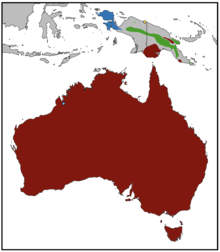
Back نضناض Arabic آكل النمل الشوكى ARZ Tachyglossidae AST Akangol (Tachyglossidae) AVK Yexidnalar Azerbaijani Яхідны Byelorussian Яхідны BE-X-OLD Ехидни Bulgarian Ekidne Breton Equidnes Catalan
| Echidnas Temporal range:
| |
|---|---|

| |
| Short-beaked echidna | |
| Scientific classification | |
| Domain: | Eukaryota |
| Kingdom: | Animalia |
| Phylum: | Chordata |
| Class: | Mammalia |
| Order: | Monotremata |
| Superfamily: | Ornithorhynchoidea |
| Family: | Tachyglossidae Gill, 1872 |
| Type genus | |
| Tachyglossus Illiger, 1811
| |
| Species | |
|
Genus Tachyglossus | |

| |
| Echidna range | |
Echidnas (/ɪˈkɪdnəz/), sometimes known as spiny anteaters,[1] are quill-covered[2] monotremes (egg-laying mammals) belonging to the family Tachyglossidae /tækiˈɡlɒsɪdiː/, living in Australia and New Guinea. The four extant species of echidnas and the platypus are the only living mammals that lay eggs and the only surviving members of the order Monotremata.[3] The diet of some species consists of ants and termites, but they are not closely related to the American true anteaters or to hedgehogs. Their young are called puggles.
Echidnas evolved between 20 and 50 million years ago, descending from a platypus-like monotreme.[4] This ancestor was aquatic, but echidnas adapted to life on land.[4]
- ^ Cite error: The named reference
pwstSBEwas invoked but never defined (see the help page). - ^ "Spines and Quills". Animal Diversity Web. University of Michigan. Retrieved 13 September 2021.
- ^ Cite error: The named reference
nwf03was invoked but never defined (see the help page). - ^ a b Cite error: The named reference
Phillipswas invoked but never defined (see the help page).
© MMXXIII Rich X Search. We shall prevail. All rights reserved. Rich X Search